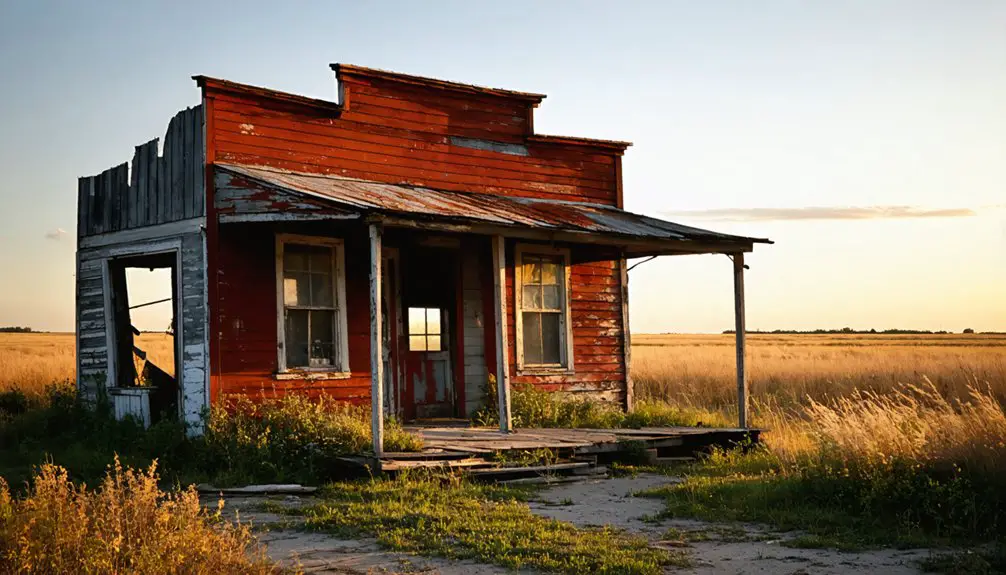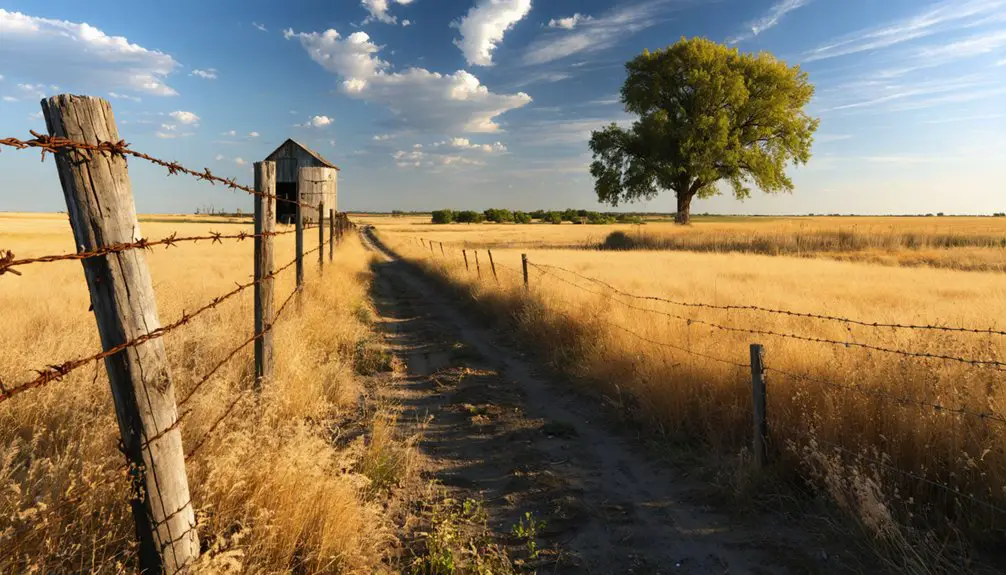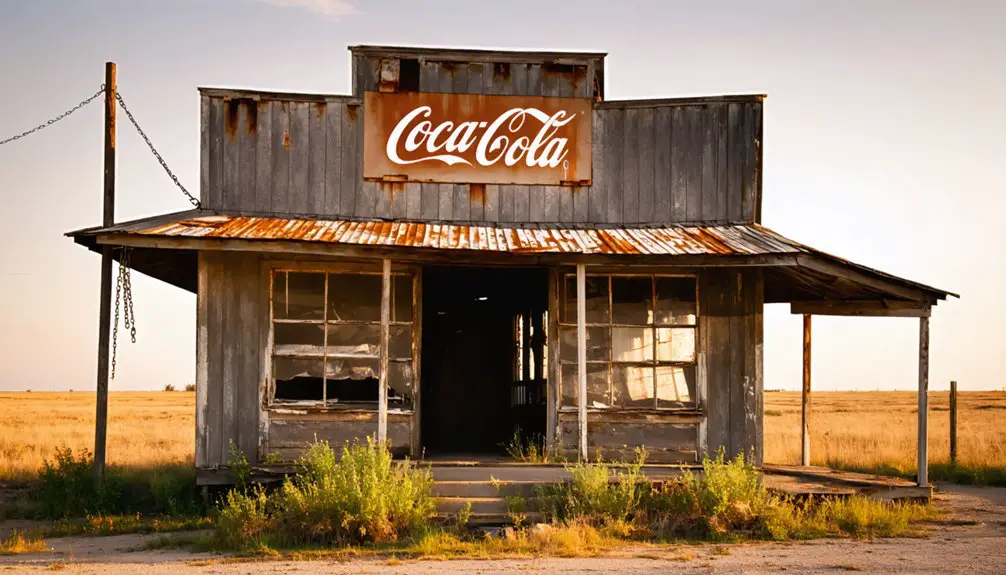You’ll find San Bernardo among Oklahoma’s 2,000 ghost towns, situated near the Red River. This former Native American settlement and French trading post thrived in the mid-1700s through farming, hunting, and commerce. The town’s decline accelerated when Interstate 40 redirected traffic away from established routes, while agricultural challenges and economic shifts drove families elsewhere. The site’s remaining structures, including the Anderson Hotel and St. Mary’s Church, hold fascinating stories of frontier life.
Key Takeaways
- San Bernardo was once a thriving Oklahoma settlement that became one of nearly 2,000 ghost towns across the state.
- The town’s decline accelerated after Interstate 40’s construction diverted traffic away from established routes through the community.
- Notable structures include the Anderson Hotel, St. Mary’s Church, and a railroad depot, showcasing early 1900s architecture.
- The site spans 35-40 acres and was originally centered around Wichita families who farmed near the Red River.
- Local folklore includes ghost stories and tales of a spectral caretaker who reportedly protects the ruins from vandalism.
Origins and Historical Context
Although San Bernardo’s origins remain tied to Oklahoma’s rich history of ghost towns, it emerged during a significant period when the state contained nearly 2,000 abandoned settlements.
Like many of its contemporaries, San Bernardo’s cultural significance reflects the complex dynamics of early Oklahoma, where Native American territories, frontier settlements, and economic booms intersected.
Early Oklahoma’s ghost towns reveal a tapestry where Native lands, pioneer outposts, and economic growth wove together a complex cultural story.
The construction of Interstate 40 led to the decline of many towns like San Bernardo as traffic patterns shifted away from established routes.
You’ll find San Bernardo’s history mirrors the common patterns of Oklahoma’s ghost towns, which often sprung up around valuable resources or along essential trade routes.
The town likely faced the familiar challenges that plagued similar settlements during the territory’s change to statehood in 1907, including shifts in railroad routes, changing legal frameworks, and the volatile nature of frontier economics that defined this transformative era in Oklahoma’s development.
Many such towns were established as liquor towns, serving alcohol to residents from neighboring dry territories during Oklahoma’s early development.
Life in Early San Bernardo
Life in early San Bernardo centered around a vibrant community of Wichita families who farmed corn, beans, pumpkins, and melons on the fertile lands near the Red River.
You’d have found the villagers engaging in daily tasks within their thatched-roof dwellings and communal spaces, protected by an impressive fortified stockade that showcased their architectural prowess.
The settlement’s strategic location made it a bustling hub for French traders in the mid-1700s, where residents exchanged local goods while maintaining their indigenous traditions despite growing European colonial pressures.
Like other early indigenous settlements between 900 and 1400 AD, the community thrived through a combination of farming and hunting practices.
The historical site spans 35-40 acres of agricultural land, preserving the legacy of this once-thriving Native American settlement.
Daily Community Activities
During San Bernardo’s heyday, residents embraced a vibrant community life centered around both work and leisure. Your daily routines would’ve revolved around farming, livestock care, and essential trades, while community gatherings helped break up the demanding work schedule. Much like the historical buggy factory in Cayuga, local craftsmen provided vital services to keep the town running. The town experienced a dramatic rise and fall like many oil boom towns across Oklahoma.
You’d have found yourself joining neighbors at the local church, dance halls, and general store to share news and entertainment.
- You could’ve enjoyed traveling performers at seasonal fairs, or participated in storytelling sessions and fiddle music with nearby families.
- You’d have spent time preserving food through canning and smoking, often sharing these tasks with other households.
Your children would’ve attended the one-room schoolhouse, though education frequently took a backseat during harvest seasons.
Trading and Commerce Patterns
When French traders established a trading post near San Bernardo in 1778, they created an essential commercial hub that would shape the region’s economic landscape for generations.
Similar to Fort Gibson’s vital role, San Bernardo became a crucial meeting point for diverse communities seeking trade opportunities.
You’d find a bustling marketplace where Wichita Indians and European traders exchanged valuable commodities like furs, buffalo hides, and agricultural goods for steel tools, firearms, and textiles.
The trade dynamics centered on San Bernardo’s strategic location near the Red River, where you could witness the convergence of multiple trade routes, including branches of the Santa Fe Trail.
Economic exchanges flourished through both river and overland transportation, creating a vibrant network of commerce that connected indigenous markets with European trading systems.
The post’s position next to a major Wichita village made it an ideal center for cultural exchange and economic growth.
Like the ancient Spiro Mounds trading center, San Bernardo demonstrated the deep-rooted tradition of commerce in Oklahoma’s history.
Local Family Settlement Stories
Native families of the Wichita tribe, particularly the Taovayas, established deep roots in San Bernardo as they built fortified settlements along the Red River in the mid-1700s.
You’ll find their family traditions woven into the fabric of daily life, from grass-thatched homes to sophisticated earthwork defenses that protected their cultural heritage. Their resourcefulness was evident in how they utilized the spring-fed stream that provided water for the entire village.
- Settlement families balanced farming and hunting, growing corn and beans while following seasonal buffalo migrations.
- The Longest family exemplified the resilient spirit of early settlers, leaving their mark on the archaeological site that bears their name today.
- Village life centered around kinship-based leadership, with families working together to maintain defenses against Spanish and English incursions.
These families adapted to European influences while preserving their traditional ways, creating a unique frontier lifestyle that merged commerce with time-honored customs. Like other village-dwelling groups in the region before 1500, they maintained permanent settlements and developed agricultural practices.
Contributing Factors to Decline
Throughout Oklahoma’s history, multiple interrelated factors contributed to San Bernardo’s transformation from a thriving community into a ghost town.
Like many Oklahoma settlements, San Bernardo’s fate was sealed by a perfect storm of economic downturns and population shifts that mirror patterns seen across the state.
Small Oklahoma towns like San Bernardo fell victim to economic decline and demographic changes that swept across the heartland.
You’ll find that the town’s decline likely accelerated with changes in transportation infrastructure, as the rise of highways and decline of railroads reshaped local commerce patterns.
Agricultural challenges hit the region hard, with drought conditions and failing crops pushing families to seek opportunities elsewhere.
The consolidation of rural schools further weakened the community’s foundations.
Without economic diversification to buffer against these changes, San Bernardo couldn’t sustain itself as residents gradually relocated to more prosperous areas.
Notable Structures and Landmarks

Despite years of abandonment, San Bernardo’s remaining structures tell a compelling story of its former significance as a frontier settlement.
You’ll find architectural styles typical of the early 1900s evident in the weathered facades of the mercantile building and general store, which once served as crucial supply centers for travelers along the region’s trade routes.
- The two-story Anderson Hotel, with its distinctive brick facade and wraparound porch, stands as a monument to the town’s historical significance during the railroad era.
- St. Mary’s Church, though partially ruined, retains its original bell tower and showcases period-specific Gothic Revival architecture.
- A preserved railroad depot, complete with original platform and loading dock, marks San Bernardo’s importance as a transportation hub in Oklahoma’s early development.
Local Stories and Legends
Beyond the weathered structures of San Bernardo, a rich tapestry of local legends has emerged from the town’s mysterious decline.
You’ll hear tales of ghostly encounters, from shadowy figures roaming abandoned buildings to unexplained footsteps echoing through empty streets. The folklore origins trace back to the town’s abrupt abandonment during early 20th-century economic shifts, with stories of hidden treasures left by settlers and bootleggers.
Former residents share accounts of a spectral caretaker who protects the ruins from vandalism, while paranormal investigators report electromagnetic anomalies and sudden cold spots.
The town’s dramatic history includes tales of violent feuds, bank robberies gone wrong, and secret prohibition-era tunnels.
Today, these stories fuel preservation efforts and draw curious visitors, helping protect San Bernardo’s remaining structures while keeping its legacy alive.
Natural Environment and Geography

San Bernardo’s location in Oklahoma placed it amid gently rolling plains with elevations ranging from 700 to 1,200 feet above sea level, where a mix of prairie grasses and oak-hickory forests dominated the landscape.
You’ll find the town’s remains in an area characterized by sandy loam and clay soils that once supported both farming and ranching activities.
The region’s continental climate brought challenging weather patterns, including hot summers and cold winters, with annual rainfall between 35-45 inches and frequent severe storms that likely influenced the town’s ultimate fate.
Terrain and Local Features
Located in Oklahoma’s vast plains region, the ghost town of San Bernardo sits amid gently rolling terrain characteristic of the Central Great Plains.
The local geology reveals sedimentary formations of sandstone and shale, with scattered shallow coal deposits that once influenced nearby mining activity. You’ll find fertile loamy soil where tallgrass prairie once thrived, now largely transformed into farmland or secondary growth.
- Small creeks and streams crisscross the landscape, creating natural drainage patterns that flow toward major rivers.
- Limestone-rich areas may feature karst topography, potentially leading to sinkholes where mining once occurred.
- The terrain shows evidence of human modification through early settlement, with scattered artifacts and remnants beneath the current surface soil.
Weather Patterns Over Time
The dramatic weather patterns of Oklahoma have shaped San Bernardo’s landscape over generations. You’ll find evidence of climate fluctuations that have tested the region’s resilience, from the devastating Dust Bowl drought of the 1930s to extreme precipitation events dropping over 9 inches of rain in a single day.
The area’s weather swings between remarkable extremes, with temperatures ranging from 120°F in scorching summers to -27°F during harsh winters.
You’re in “Tornado Alley” territory here, where spring and early summer bring powerful storms – the region saw a record 147 tornadoes in 2019 alone.
Four major drought periods have left their mark since 1909, while seasonal snowfall once reached an astounding 87.3 inches.
These patterns continue to influence the semi-arid western Oklahoma landscape where San Bernardo stands.
Visiting the Former Town Site
When planning a visit to this abandoned settlement in Oklahoma, you’ll need precise coordinates or nearby modern town references, as minimal infrastructure exists at the former town site.
For successful ghost town exploration, prepare thoroughly by researching access routes and checking property restrictions before arrival.
- Bring essential supplies including water, food, and navigation tools, as you won’t find services at this remote location.
- Wear protective clothing and sturdy boots to safely navigate overgrown terrain and foundation ruins.
- Document your discoveries through photos while preserving historical artifacts in their original locations.
Your visit offers a unique glimpse into Oklahoma’s past, with remaining foundations and old roadbeds telling stories of frontier life.
Step carefully through history as crumbling foundations and weathered paths reveal echoes of Oklahoma’s pioneering spirit.
While most structures have vanished, the site’s quiet solitude creates an authentic connection to the region’s settlement history.
Frequently Asked Questions
Are There Any Surviving Descendants of San Bernardo’s Original Settlers?
You can’t definitively confirm surviving descendants since settler genealogy records and family histories aren’t readily available. To trace potential descendants, you’d need extensive research through Jefferson County’s historical archives.
What Items Have Been Found by Metal Detector Enthusiasts at the Site?
You’ll find metal detecting finds like Indian Head pennies, Buffalo nickels, mining tools, ammunition casings, and personal artifacts including jewelry, buttons, and household items scattered across the historical townsite.
Did Any Famous Outlaws or Historical Figures Pass Through San Bernardo?
You won’t find any evidence of famous outlaws or notable historical figures in San Bernardo’s history. There’s no historical significance linking this location to documented Wild West personalities or outlaw activity.
Were There Any Native American Settlements in the Area Before San Bernardo?
You’ll find evidence of native tribes like the Wichita, who built fortified settlements with stockades near San Bernardo. Archaeological findings show earlier Spiro Mound builders inhabited the region from 500-1300 A.D.
What Happened to the Town’s Official Records and Documents?
You won’t find many original records since most were lost or scattered. The town’s lost archives and missing documents likely disappeared during abandonment, with only Spanish expedition records surviving elsewhere.
References
- https://en.wikipedia.org/wiki/List_of_ghost_towns_in_Oklahoma
- https://baselocal.com/ok/a/exploring-oklahomas-ghost-towns-maps-history-travel-tips/
- https://www.okhistory.org/publications/enc/entry?entry=GH002
- https://sites.rootsweb.com/~oktttp/ghost_towns/ghost_towns.htm
- https://abandonedok.com/class/disappearing-town/
- https://okmag.com/blog/a-ghostly-site/
- https://bestsmalltownsinamerica.com/oklahoma-ghost-towns/
- http://blogoklahoma.us/place/280/jefferson/san-bernardo
- https://www.ereferencedesk.com/resources/state-early-history/oklahoma.html
- https://www.hmdb.org/m.asp?m=174618



